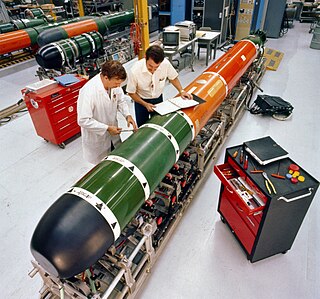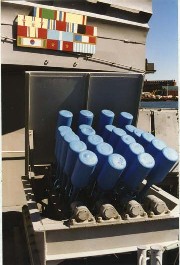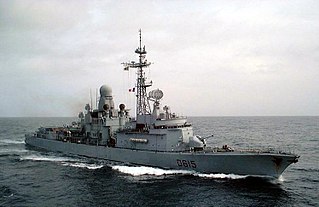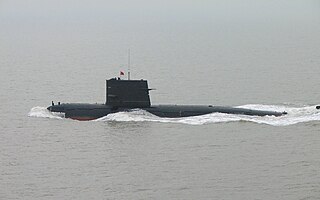| Torped 45 | |
|---|---|
| Type | Lightweight ASW torpedo |
| Place of origin | Sweden |
| Service history | |
| In service | 1995–today |
| Used by | Swedish Navy Pakistan Navy Finnish Navy |
| Production history | |
| Designed | 1995 |
| Manufacturer | Saab Dynamics |
| Variants | Mod 1 "Torpedo 45 - Technical specifications". SAAB. Archived from the original on 25 October 2014. Retrieved 25 October 2014. |
| Specifications | |
| Mass | 320 kg |
| Length | 2,850 mm |
| Diameter | 400 mm |
| Engine | Electric DC motor with gearbox |
Guidance system | Hydro-acoustic homing combined with wire guidance and on-board computer |
Launch platform | Stationary, surface vessels, submarines and helicopters |
The Torped 45 is a lightweight torpedo intended for ASW and surface targets, providing multiple-target active/passive homing combined with wire guidance. It is designed and manufactured by Saab Dynamics. It was designed for the Swedish Navy, based on the experience gathered from the well proven 43-series of torpedoes.
Torpedo 45 can be launched from a variety of platforms including stationary, surface vessels, submarines and helicopters. It was specifically designed to operate against shallow-water targets and surface vessels. It is controlled using wire guidance and has a hydro-acoustic homing system for the final phase. The torpedo has features that are unique for lightweight torpedoes.
In exercise torpedo launches, the warhead is replaced by an exercise head carrying identical homing equipment. Instead of explosives, the exercise head has a tape recorder for logging a number of torpedo functions, communication with fire-control and hit indications. After each run, the recordings are analysed and torpedo and fire-control functions are checked.
The Torped 45 is set to be replaced by the newer Torped 47 in Swedish Service fully 2024.

A missile is an airborne ranged weapon capable of self-propelled flight aided usually by a propellant, jet engine or rocket motor.

A modern torpedo is an underwater ranged weapon launched above or below the water surface, self-propelled towards a target, and with an explosive warhead designed to detonate either on contact with or in proximity to the target. Historically, such a device was called an automotive, automobile, locomotive, or fish torpedo; colloquially a fish. The term torpedo originally applied to a variety of devices, most of which would today be called mines. From about 1900, torpedo has been used strictly to designate a self-propelled underwater explosive device.
The Mark 24 Tigerfish was a heavyweight acoustic homing torpedo used by the Royal Navy (RN) during the 1980s and 90s. Conceptual development dates to the mid-1950s, and formally started in 1959 with a target introduction date in 1969. A lengthy development process led to a greatly reduced performance requirement, including the removal of anti-surface capabilities. The first prototype "Tiger Fish" examples were delivered in 1967.
The Spearfish torpedo is the heavy torpedo used by the submarines of the Royal Navy. It can be guided by wire or by autonomous active or passive sonar, and provides both anti-submarine warfare (ASW) and anti-surface warfare (ASuW) capability. Spearfish development began in the 1970s, with production starting in 1988, and deployment in 1992. By 2004, the new weapon had completely replaced the older Tigerfish torpedo.

The Mark 48 and its improved Advanced Capability (ADCAP) variant are American heavyweight submarine-launched torpedoes. They were designed to sink deep-diving nuclear-powered submarines and high-performance surface ships.

The Mark 50 torpedo is a U.S. Navy advanced lightweight torpedo for use against fast, deep-diving submarines. The Mk 50 can be launched from all anti-submarine aircraft and from torpedo tubes aboard surface combatant ships. The Mk 50 was intended to replace the Mk 46 as the fleet's lightweight torpedo. Instead the Mark 46 will be replaced with the Mark 54 LHT.

The Delhi-class destroyers are guided-missile destroyers of the Indian Navy. Three ships of this class are in active service. The Delhi-class vessels were the largest vessels to be built in India at the time of their commissioning. The ships were built by Mazagon Dock Limited (MDL) at a cost of ₹750 crore each.

An anti-submarine weapon (ASW) is any one of a number of devices that are intended to act against a submarine and its crew, to destroy (sink) the vessel or reduce its capability as a weapon of war. In its simplest sense, an anti-submarine weapon is usually a projectile, missile or bomb that is optimized to destroy submarines.

The Cassard class was a class of two anti-air warfare destroyers of the French Navy introduced in the latter 1980s/early 1990s. The class was an air defence variant of the Georges Leygues class. The two classes have a different armament and propulsion system mounted on an identical hull. Their primary role was to provide air cover for a fleet, an aeronaval group, a convoy & a littoral point. Their secondary role was to manage air assets coordination & aircraft control for the force, especially through Link 16.They can also be used for research, identification or presence missions. Both ships were assigned to the Force d'Action Navale. The lead ship of the class, Cassard, was retired in 2019 followed by the retirement of Jean Bart in 2021.

The Mark 54 Lightweight Torpedo is a standard 12.75-inch (324 mm) anti-submarine warfare (ASW) torpedo used by the United States Navy.

The Sting Ray is a British acoustic homing lightweight torpedo (LWT) manufactured by GEC-Marconi, who were later bought out by BAE Systems. It entered service in 1983.

The Mark 45 anti-submarine torpedo, a.k.a. ASTOR, was a submarine-launched wire-guided nuclear torpedo designed by the United States Navy for use against high-speed, deep-diving, enemy submarines. This was one of several weapons recommended for implementation by Project Nobska, a 1956 summer study on submarine warfare. The 19-inch (480 mm)-diameter torpedo was fitted with a W34 nuclear warhead. The need to maintain direct control over the warhead meant that a wire connection had to be maintained between the torpedo and submarine until detonation. Wire guidance systems were piggybacked onto this cable, and the torpedo had no homing capability. The design was completed in 1960, and 600 torpedoes were built between 1963 and 1976, when ASTOR was replaced by the Mark 48 torpedo.
The SS.12 and AS.12 are two variants of the same missile: SS for surface-to-surface and AS for air-to-surface. It was designed in 1955–1957 by Nord Aviation, later Aérospatiale. It was a derivative of the NORD SS.10 and SS.11 missiles which were surface-to-surface wire-guided missiles for use by infantry, vehicle or a helicopter primarily in the anti-tank role, but also anti-material, anti-personnel and against light field fortifications. The SS.12/AS.12 was basically a scaled-up version of the SS.11/AS.11, with a massive increase in range and warhead weight. The SS.12/AS.12 original mission was primarily to be anti-shipping from naval helicopters and combat aircraft or ground launchers, and secondarily for use against heavy field fortifications. The range and the destructive power of its warhead are roughly equivalent to a 127 mm (5-inch) artillery shell.

The Mark 24 mine is an air-dropped anti-submarine (ASW) acoustic torpedo developed by the United States during World War II; it was called a mine to conceal its capabilities. The torpedo entered service with the Allies in March 1943; the United States Navy (USN) used it until 1948. Approximately 4,000 were produced. Of the 340 deployed during the war, 204 were fired, sinking 37 and damaging 18 Axis submarines.

The Mark 37 torpedo is a torpedo with electrical propulsion, developed for the US Navy after World War II. It entered service with the US Navy in the early 1950s, with over 3,300 produced. It was phased out of service with the US Navy during the 1970s, and the stockpiles were sold to foreign navies.

The Type 039 submarine is a class of diesel-electric submarines of the People's Liberation Army Navy. The class is the first diesel-electric submarine to be made in China and also the first Chinese made diesel-electric submarine to use the teardrop hull shape. Altogether thirteen vessels were completed to the Song Class design between 1999 and 2006, with three variants as the type developed.

This is a list of Active Royal Navy weapon systems.
A nuclear torpedo is a torpedo armed with a nuclear warhead. The idea behind the nuclear warheads in a torpedo was to create a much bigger explosive blast. Later analysis suggested that smaller, more accurate, and faster torpedoes were more efficient and effective.
The Torped 47 or SLWT is a new lightweight torpedo intended for ASW and surface targets, providing multiple-target active/passive homing combined with wire guidance. It is designed and manufactured by Saab Dynamics as a replacement for the Torped 45.
The SST family is a series of German torpedoes.